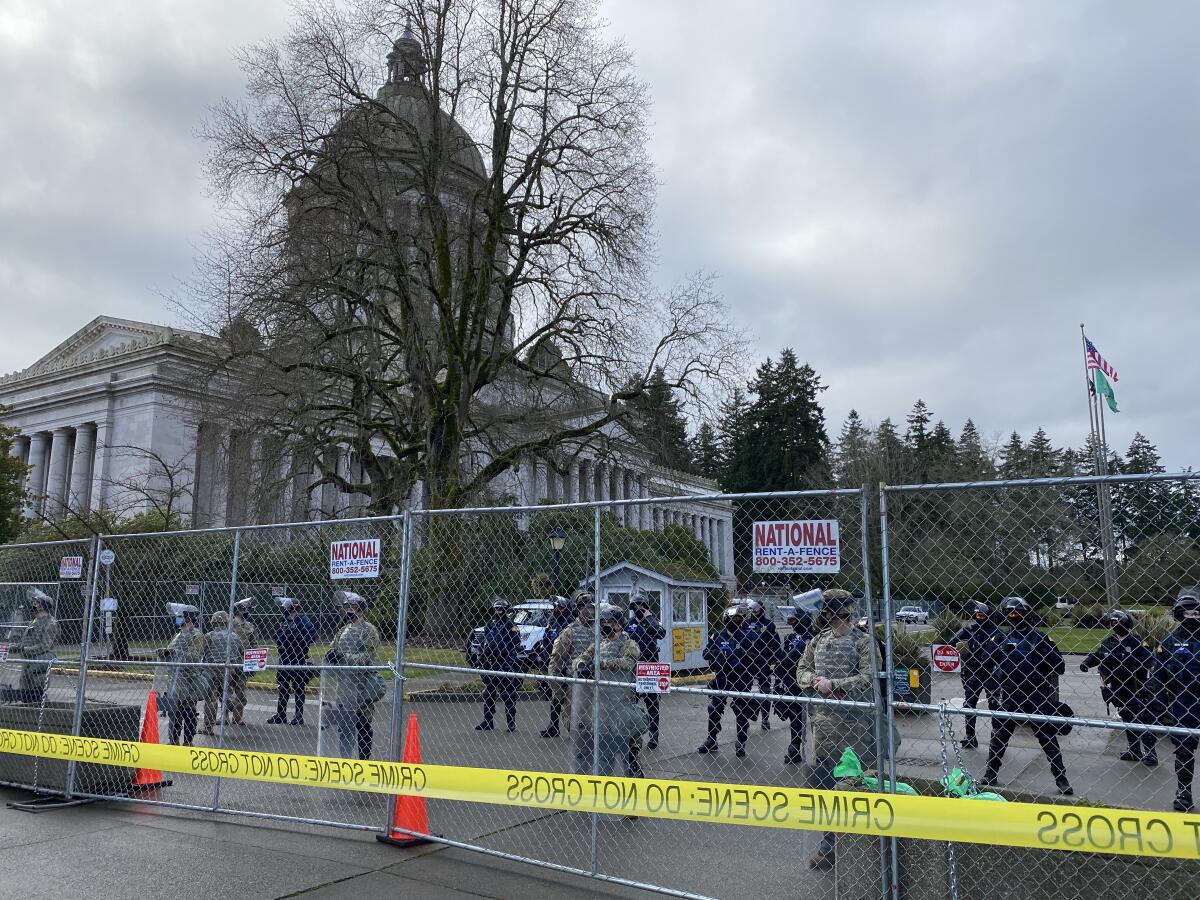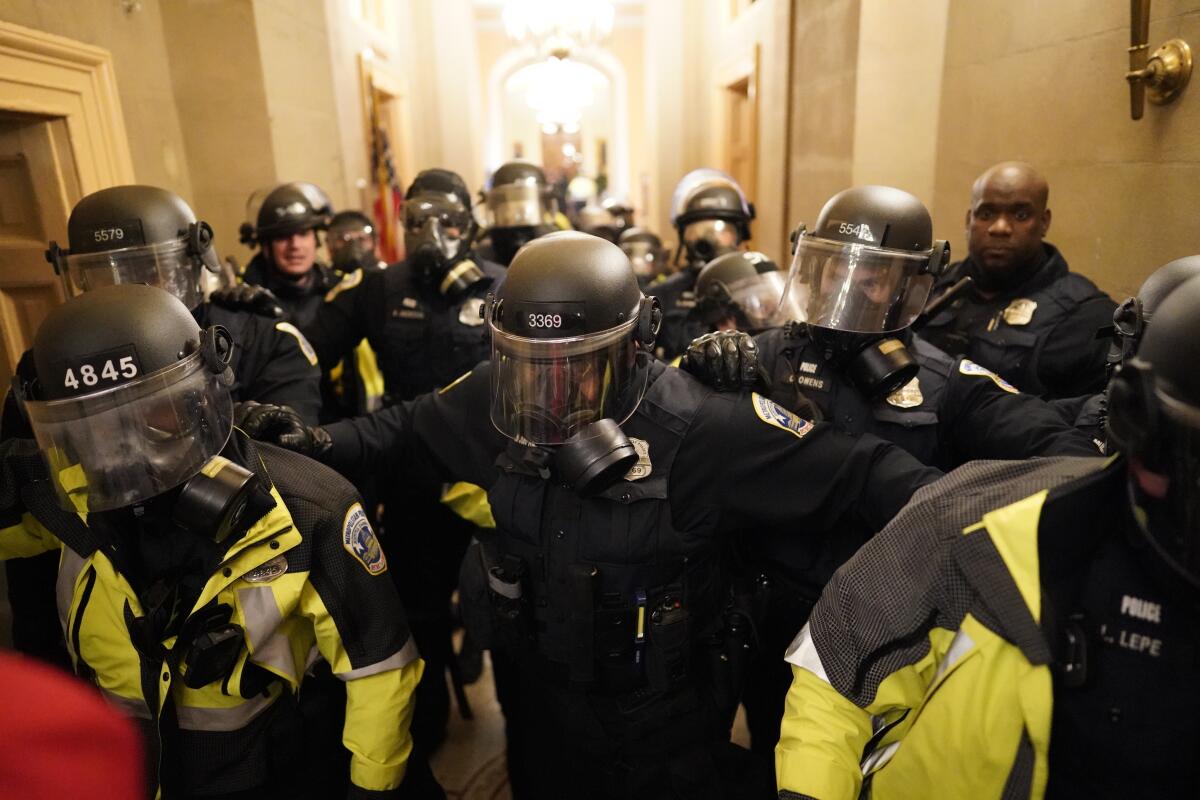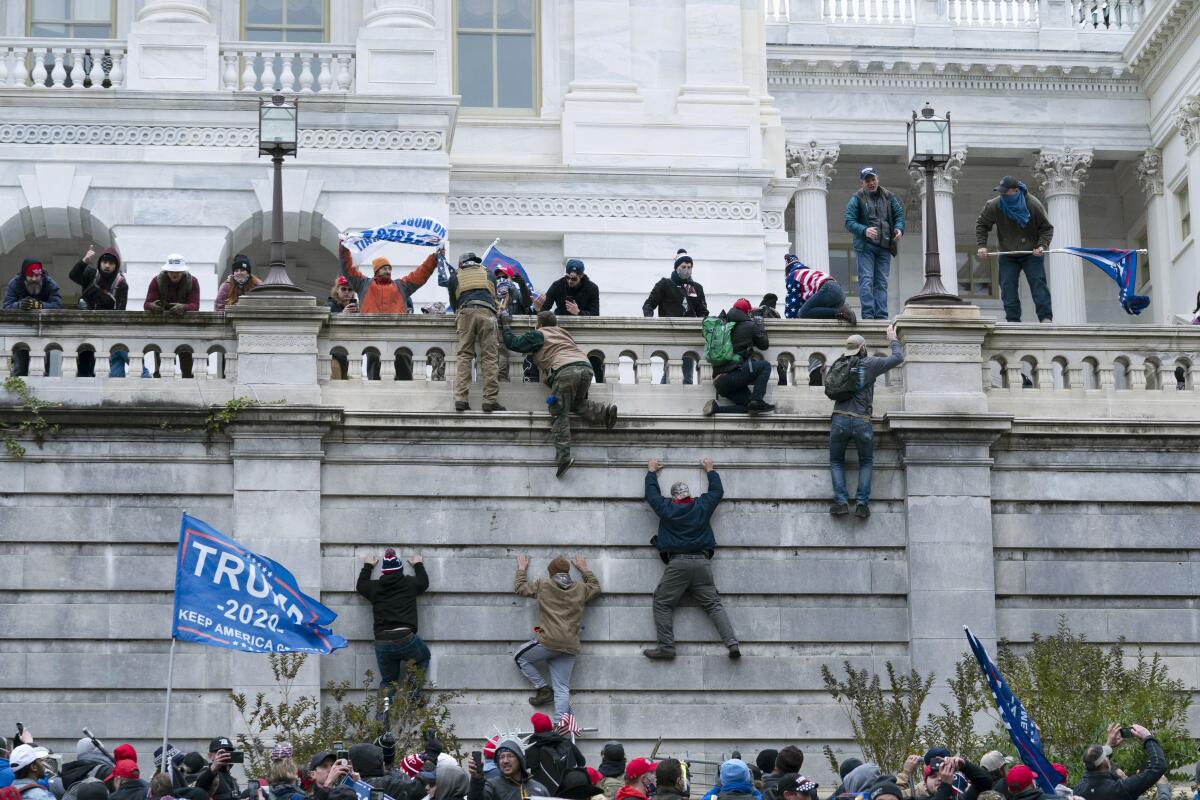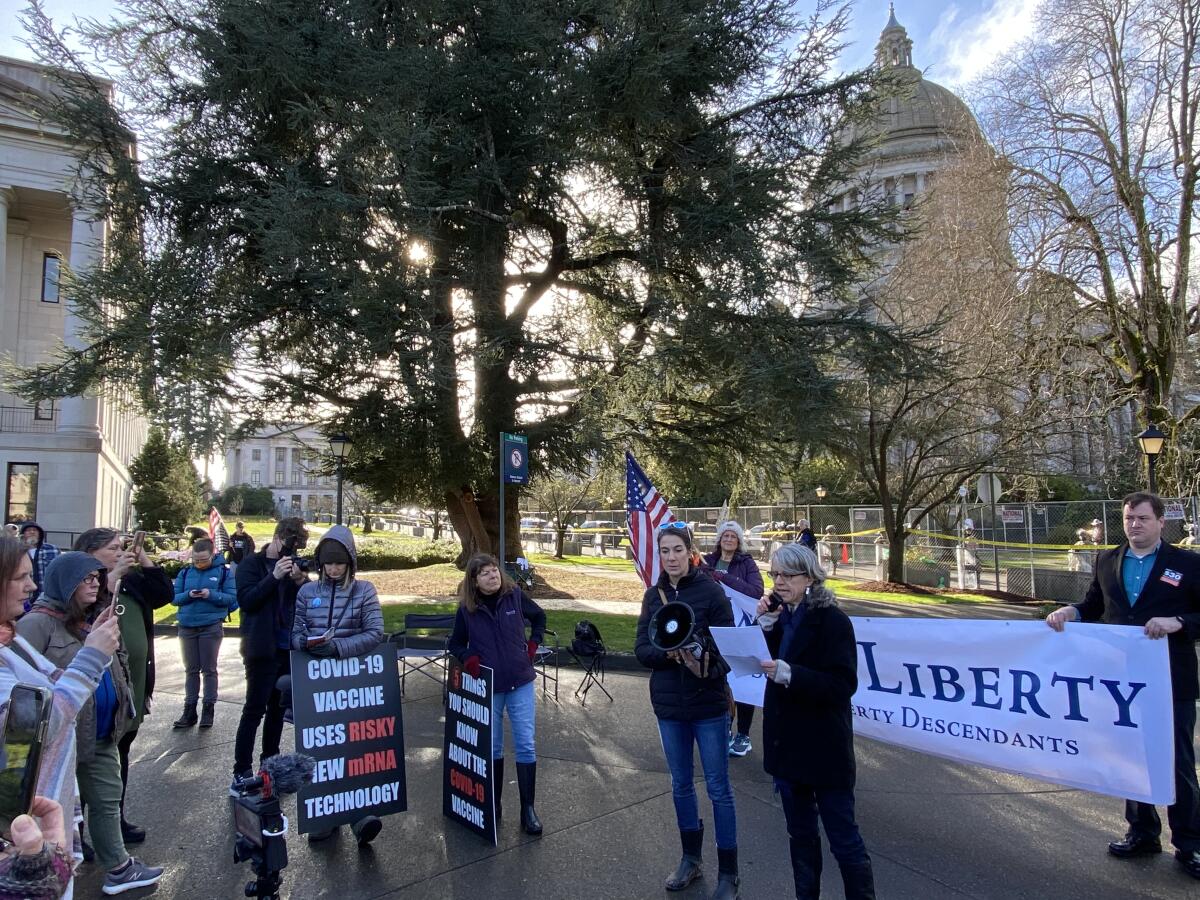Police and National Guard prepare for attacks on statehouses as FBI warns of ‘armed protests’

- Share via
OLYMPIA, Wash. — State capitol buildings across the nation — including in Austin, Texas, where lawmakers are carrying weapons — have called in the National Guard and erected barricades over fears that far-right groups and President Trump’s supporters are plotting a second wave of uprisings after last week’s storming of Congress.
An FBI warning of “armed protests” planned at all 50 statehouses and the U.S. Capitol in the days leading up to President-elect Joe Biden’s inauguration Jan. 20 has brought out SWAT teams and extra law enforcement officers dressed in camouflage, helmets, face shields and bulletproof vests.
The high alert unnerved an America that over the last seven days has been shaken by disturbing images: representatives fleeing a violent mob breaking into the nation’s Capitol, the impeachment for the second time of an increasingly reviled president, and scenes of rage, tears and threats playing out at airports and on city streets that underscore a dangerous political divide.
It was difficult to predict where extremist groups such as the Proud Boys, Oath Keepers and the III% Security Force, a.k.a. Three Percenters, would next appear. Since last week’s insurrection, social media outlets that the far right often use to communicate, including Parler, have been shut down or scaled back. Law enforcement officials have been scouring other channels to gauge how potent protests may be in coming days.
In a national conference call Wednesday, FBI Director Christopher Wray and other federal officials asked local authorities to be vigilant and share intelligence.
“The message was that you can’t share enough information,” said Houston Police Chief Art Acevedo, whose staff monitored the call.
The federal request came as an off-duty Houston officer was relieved of duty for his alleged participation in the U.S. Capitol siege.
In Washington state, the largest security force ever seen at the Capitol greeted lawmakers starting their annual session this week. State police and more than 750 National Guard troops in riot gear stood in shifts behind chain-link fencing around the statehouse in Olympia, where Trump supporters have protested COVID-19 lockdowns in recent months.
“It’s tragic that we have to have those fences and additional personnel in place,” said Chris Loftis, Washington State Patrol communications director. “But believe it: We are resolved that we are going to protect the people, the place and the process.”
The riot in the U.S. Capitol on Jan. 6 left five people dead, including a police officer and a rioter who supported Trump’s unfounded claims that election fraud had cost him the November election. More than 70 people have been charged with crimes in connection with the insurgency, and authorities combing through social media and following tips from the public expect hundreds of arrests.

At the Texas state Capitol in Austin, over 100 state troopers, some in riot gear, guarded entrances this week as lawmakers returned to work. The first day of the state’s biennial legislative session drew a small number of demonstrators, including several men dressed in fatigues carrying a “Don’t tread on me” flag and long rifles. The building was open to visitors — including those who were licensed to carry concealed weapons.
The U.S. military and law enforcement are taking unprecedented measures to lock down the nation’s capital to prevent violence tied to Trump’s impeachment and President-elect Joe Biden’s inauguration.
After the attack in Washington, D.C., last week, Texas state Sen. José Menéndez and several fellow Democrats sent a letter to the Republican governor and legislative leaders asking them to ban weapons at the state Capitol. Menéndez said no response had been received.
He said the head of the Texas Department of Public Safety shared his concerns and promised that state troopers and other law enforcement would be deployed to protect returning lawmakers.
“We saw a lot of preparation here from DPS and from the National Guard — a show of strength,” Menéndez said.

Though some Texas legislators said they were armed and ready to defend themselves, Menéndez said the Capitol siege showed how difficult that could be, especially for anyone not trained to respond to such attacks. Menéndez, who’s from San Antonio, noted that Texas had 181 state legislators — nearly as many, he said, as tried to defend the Alamo from Mexican troops in 1836.
“And you know what happened at the Alamo,” he said.
A Michigan state Capitol commission voted this week to ban the open carrying of firearms inside the statehouse in Lansing. People are permitted to enter with concealed guns. Democratic lawmakers have been demanding a complete ban on firearms since last year, when armed protesters challenging the state’s COVID-19 lockdowns stormed the building. Later, 14 men — some of whom had participated in that protest — were arrested in connection with a plot to kidnap Democratic Gov. Gretchen Whitmer.
Michigan State Police increased their presence around the state Capitol, but Lansing’s mayor asked Whitmer to send in the National Guard. State Atty. Gen. Dana Nessel, a Democrat who’s been threatened at her home by pro-Trump protesters in recent weeks, warned the public on Twitter: “Our state Capitol is not safe.”
Police responded last week to a bomb threat at the Michigan Capitol against a lawmaker who had been critical of Trump. State Rep. Sarah Anthony, a Lansing Democrat, said she had lobbied the state commission for months to ban weapons at the Capitol, and she called the new ban on open carry “a half-measure.”
Anthony said incoming freshman legislators had been asking: “How do I procure a bulletproof vest? How do I keep myself safe? How do I select my seat on the House floor so that, if there’s an emergency, I can leave the building?
“I never imagined needing a bulletproof vest coming in to work,” she said. “Many of us just feel we are vulnerable in that Capitol building because the tensions are so high.”
Anthony plans to make the first legislation she introduces this week a bill encouraging Congress to make domestic terrorism a federal crime.
In Georgia, the scene of protests after Trump lost the state and Republicans lost two U.S. Senate races, lawmakers returned to the Capitol in Atlanta on Monday to discover a new iron fence around the building and armed troopers standing guard.
“A fence that was erected in large part as a response to the Black Lives Matter protests when there wasn’t any violence at the Capitol is now going to be used to protect us from the — I don’t even know what to call them — the Trumpists,” said state Rep. Teri Anulewicz, a Democrat from the suburb of Smyrna.
Anulewicz said “heavily armed” state troopers were “comforting, but it’s also concerning that this is where we are.”
She stopped wearing her name tag outside the Capitol after receiving more than 10,000 emails, some of them threatening, from Trump supporters across the country urging her not to let the election be “stolen” from the president.
“It’s chilling to know there is a real undercurrent to these threats — we saw it underscored in Washington,” Anulewicz said.
Arizona authorities have put up a temporary fence around their state Capitol, just as they did over the summer during Black Lives Matter protests. Visitors can enter only by appointment.
“We already had a plan in place so we could be able to do this quickly,” said Arizona Senate President Karen Fann, a Republican from Prescott. “We hope we can get past this so we can take this down and let the people use their house safely.”
It “breaks my heart,” Fann said of the fence, which she called “ugly.” She said barring the public from the building was “un-American” but necessary given the security warnings.
Last Wednesday, several hundred people, many of them armed, gathered outside the building, she said. But banning firearms from the area had not been suggested, she said, adding, “This is Arizona, so you know that’s not going to happen.”
In Salem, Ore., dozens of police officers guarded the Capitol building as newly elected legislators took their oath of office just weeks after right-wing protesters had stormed the building, attacking officers after a Republican lawmaker opened a locked door. The lawmaker has been stripped of his committee assignments and fined for the damage.

Washington Gov. Jay Inslee, a Democrat, mobilized National Guard troops in Olympia after about 200 Trump supporters marched from the Capitol on Jan. 6 and broke through a gate at his official residence, then protested on the front lawn.
Troops and officers at the state Capitol building have far outnumbered demonstrators at protests this week.
Conservative activist Jessica Karraker led a rally of about 100 people in Olympia on Sunday, calling on lawmakers to limit Inslee’s emergency powers and to outlaw discrimination against people who decline COVID-19 vaccines. She criticized the increased security, saying it denied citizens access.
But Loftis, the State Patrol spokesman, said the security enabled legislators to convene safely at the statehouse. “It would literally take an army to get into the Capitol building now,” he said.
More to Read
Sign up for Essential California
The most important California stories and recommendations in your inbox every morning.
You may occasionally receive promotional content from the Los Angeles Times.













